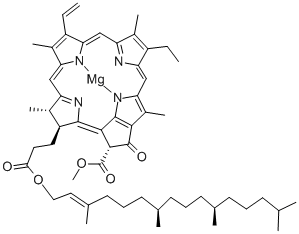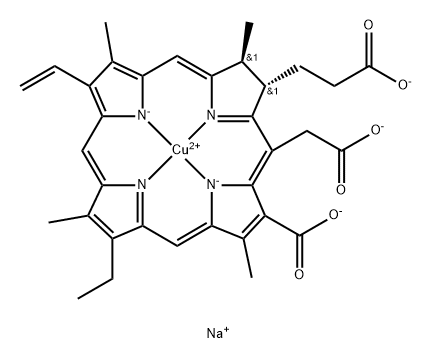Chlorophyll a , ≥85.0%(HPLC) , 479-61-8
Synonym(s):
Chlorophyll a
CAS NO.:479-61-8
Empirical Formula: C55H72MgN4O5
Molecular Weight: 893.49
MDL number: MFCD00079050
EINECS: 207-536-6
| Pack Size | Price | Stock | Quantity |
| 1MG | RMB1117.60 | In Stock |
|
| 5MG | RMB4237.60 | In Stock |
|
| others | Enquire |
PRODUCT Properties
| Melting point: | 117-120° |
| alpha | D20 -262° (acetone) |
| storage temp. | -20°C |
| solubility | diethyl ether: soluble0.1mg/10 mL |
| form | powder |
| color | Green to Black Semi-Solid |
| biological source | spinach |
| ε(extinction coefficient) | 11.1-12.1 × 104 at 428-430nm in diethyl ether 8.3-9.4 × 104 at 660-662nm in diethyl ether |
| Merck | 13,2174 |
| BRN | 3586237 |
| Stability: | Stable, but may discolour upon exposure to light. Incompatible with strong oxidizing agents. May be air sensitive. |
| InChIKey | ATNHDLDRLWWWCB-AENOIHSZSA-M |
| LogP | 16.534 (est) |
| EPA Substance Registry System | Chlorophyll a (479-61-8) |
Description and Uses
Chlorophyll is the green pigment in plants that allows them to create energy from light – to photosynthesize. Chlorophyll A and B are two major types of chlorophyll found in plants and green algae. Both are involved in the process photosynthesis. Both chlorophyll A and B are found in chloroplasts, associated with integral membrane proteins in the thylakoid membrane. The main difference between chlorophyll A and B is their role in photosynthesis? chlorophyll A is the principal pigment involved in the photosynthesis whereas chlorophyll B is the accessory pigment, collecting the energy in order to pass into chlorophyll A. In chlorophyll A, the most effectively absorbing wavelengths of the spectrum are 429 nm and 659 nm, which are responsible for violet-blue and orange-red colors, respectively.
Chlorophyll A is a photosynthetic pigment that is essential for photosynthesis of eukaryotes and cyanobacteria, acting as a primary donor in the electron transport chain. Dyes and metabolites.
Safety
| Symbol(GHS) |  GHS08 |
| Signal word | Danger |
| Hazard statements | H302-H304 |
| Precautionary statements | P264-P270-P301+P312-P330-P501 |
| Safety Statements | 22-24/25 |
| WGK Germany | 3 |
| RTECS | FW6420000 |
| F | 8-10-23 |
| HS Code | 29339900 |




